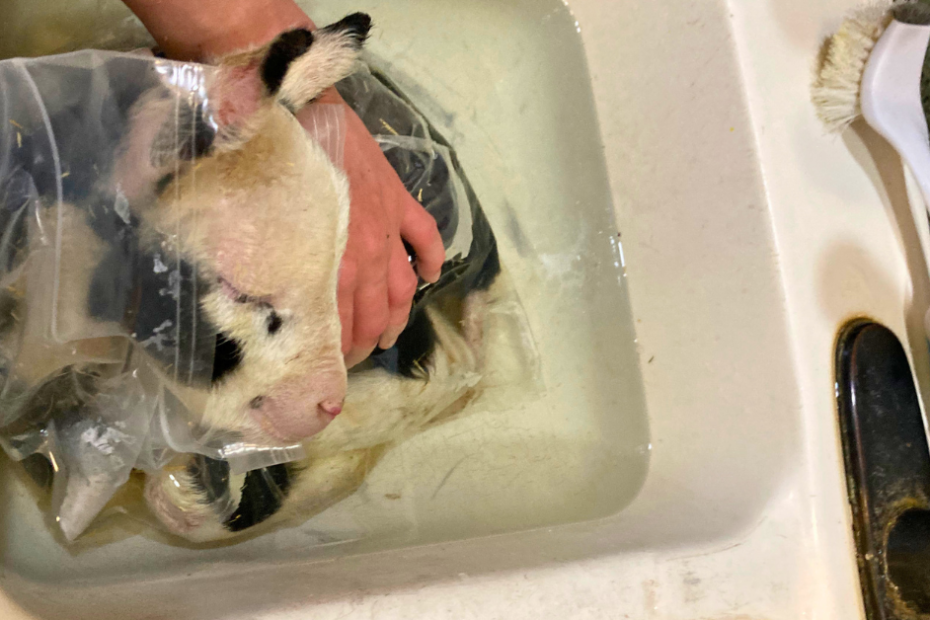How to save a cold (hypothermic) lamb
If you need fast help visit this site for a decision tree: https://epidemiology.sruc.ac.uk/shiny/consulting/new_born_lambs/
You found a cold lamb flat out. Do you know what to do to save it? You don’t have much time and what you do next is important. Read on to find out how to save a cold lamb and not make the mistakes that could cost the lamb its life.
I have saved cold lambs before. I have lost cold lambs. Depending on the age and the condition of the lamb, what you need to do to save them is different!
How to save a cold (hypothermic) lamb
The most important things you need to save a hypothermic lamb is to give it a source of energy (colostrum, milk, glucose or dextrose) and warm it back up (slowly).
Do this first if you find a cold lamb
I came across this flow chart to help you decide how to treat a cold lamb, because the treatment varies based on a few factors. I ABSOLUTELY love this and wanted to share it with you because I don’t care how many times something happens, when a situation like this comes up you are always a bit frazzled and a quick, to the point chart like this is so helpful in those times.
You found a cold lamb, now what?
The first thing you should do is take the lamb’s temperature. Now obviously, if the lamb is laid out flat and is unresponsive it is safe to say you don’t need to waste the time to take its temperature.
Scoop the lamb up and get it an IP shot ASAP!
Lamb temp 98-102
If the lamb’s temp is 98-102 it is suffering from mild to moderate hypothermia. If the lamb can hold its head up and swallow, tube feed it colostrum or milk (depending on age). If it is wet at all, dry the lamb with a towel or dry heat like a blow dryer. Return to it’s mother and recheck in thirty minutes to one hour.
Lamb temp below 98 (Severe hypothermia)
If the lamb can hold its head up, give it colostrum or milk by stomach tube, then warm the lamb. It is very important to give the source of energy FIRST, then warm the lamb.
If the lamb cannot hold its own head up, you will have to give it an intraperitoneal injection. Lambs need an energy source at the rate of 5ml / lb of body weight. Onn average this will be around 30ml for a triplet, 40ml for a twin and 50ml for a single lamb.
You can use glucose or dextrose, see the charts below.
20% GLUCOSE: this is already the right percentage, just draw up the amount you need and warm it under the tap.
How to give an intraperitoneal injection
Hold the lamb dangling by its front legs with your non dominant hand.
With your dominant hand, locate the injection site – 1/2” (one finger width) to the side of the navel, and 1” (or two finger widths) below the navel.
Insert a 1” long, 20 gauge needle at this location at a 45 degree angle with the needle pointed toward the tail.
What to do after giving an intraperitoneal injection
Put the lambing in a warming box to warm up. Dry heat is your best option. I like to put the lamb in a box covered with a towel and stick a blow dryer in there.
You can also use a heating pad / blanket. Or aim a small heater at the lamb in the box – just make sure it doesn’t get overheated. Recheck the lamb’s temperature in 30 minutes.
Once the lamb is holding it’s head up, you can now tube it with colostrum if less than 24 hours old or milk if over 24 hours old. Give 20ml / lb of body weight.
If the lamb is warm and doing well, return it to it’s mother to nurse. Keep a close eye on the lamb to make sure she is able to nurse and not getting cold again.
You did it, great job!
Links to stuff mentioned in this post:
A few notes about hypothermic lambs
Cold lambs are more often the result of starvation than actually cold weather! This is crazy, but true. Even if you see your lamb sucking, that doesn’t necessarily mean it is getting enough to eat. Sometimes lambs can starve and become hypothermic because other lambs are robbing all of their mommas milk!
A quick tip I love on heating colostrum: if the water you are using to heat it is too hot for you hand, then it is too hot for colostrum. The colostrum needs to be heated to 102℉. If the colostrum is too thick to flow through a tube, you can dilute it slightly with warm water until it flows.
If you need to feed cow colostrum (not ideal but better than nothing) increase the amount you feed by 30%.
A lot of things you will read on hypothermia will ask you how old the lamb is. Most people will tell you if a lamb is under 5 hours old, it still has a source of brown fat for energy and that you do not need to give it an energy source.
This may be true if a lamb is cold but still holding its head up… but what if you find a newborn that is flat out? That I would still give an IP injection!
The amount of brown fat a lamb has is NOT constant. It depends on factors such as the ewe’s nutrition and the litter size. A tiny triplet is likely to have much less brown fat than a fat, single lamb. Likewise, a well fed ewe is going to have lambs that have more brown fat than a ewe that was half starved during her gestation.
One more thing: You may see people warming lambs in water. Please be very careful doing this, especially without giving them a source of energy FIRST! This method can warm the lamb TOO QUICKLY, causing hypoglycemic shock and death. Dry, slow heat is really the best way to warm a lamb.
Important!
If you do not have glucose or dextrose on hand what do you do?
If it were me, and I knew the lamb was likely to die without an immediate energy source, I would try to make my own concoction.
Table sugar is 50% glucose. I think I would try mixing 40 grams of sugar with 100mls of water. Then from that, draw up the amount I need. Remember, a lamb needs 5mls / pound, so for a 10lb lamb you’d need 50ml of this solution.
The above paragraph is 100% just me wondering out loud and NOT FACT, so please use at your own risk. My thought is this: if you have a severely hypothermic lamb and you don’t have glucose or dextrose on hand, it is going to die without an energy source. Almost everyone has sugar on hand, why not try this as a last ditch effort? I think I would also give an injection of Vitamin B to help the lamb utilize the sugar, and if it lives, follow with an injection of antibiotics (your call) just because the sugar solution you made up isn’t sterile and may introduce bacteria. Worth a shot anyway!
I hope this post gave you a clear idea of what to do and when to do it when you find a hypothermic lamb. Don’t be afraid to take action and do something you have never done before. It is hard to lose a lamb but the most important thing is to learn from our mistakes so we can save the next one.
Pin it for later:




